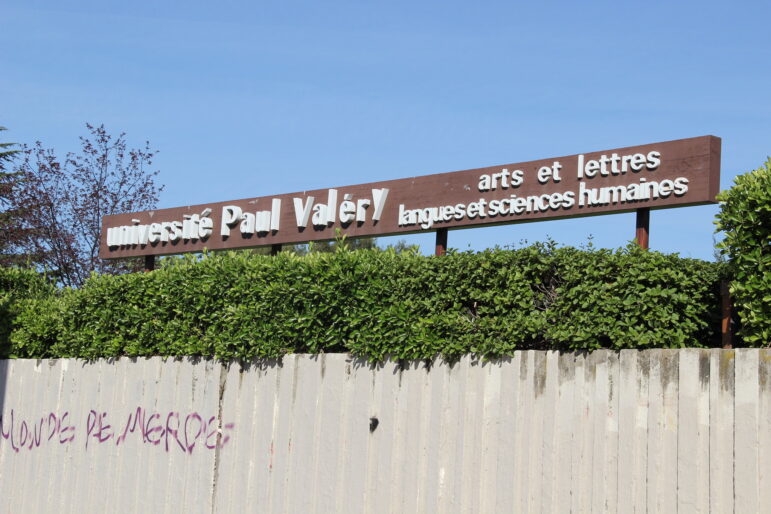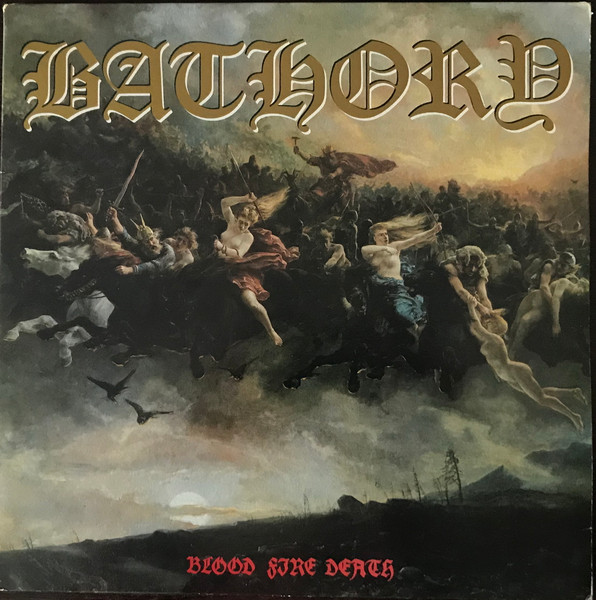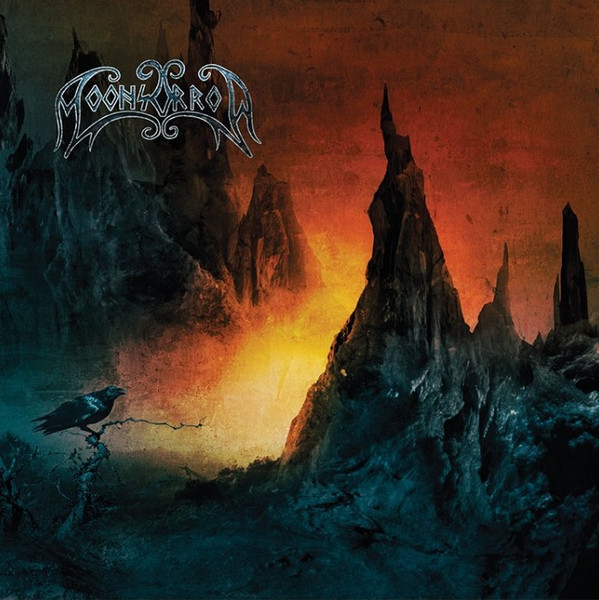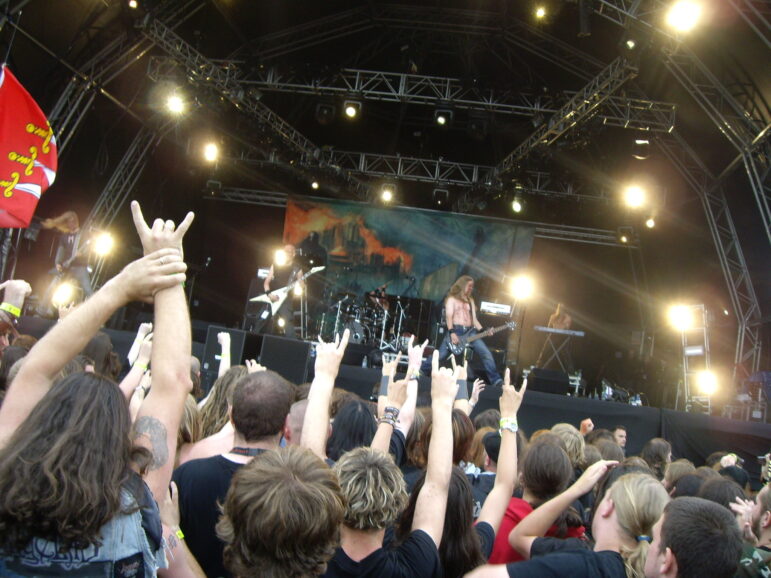
“You know what? I I feel like listening to something Pagan!”
That came pretty much out of nowhere out of Laetitia’s mouth, and although this happened over fifteen years ago, I remember as if it were yesterday.

The college where this story takes place. Photo by Camille Stromboni (2014). Shared via CC BY ND license.
It was a grey winter day on the campus – not quite cold, for this was southern France, but still somewhat gloomy. We had just gone through a long lecture on, if I remember correctly, Byzantine History and just had a few minutes before our next class, so we quickly grabbed a pair of baguettes at the student cafeteria and sat down out on the concrete to wolf them down.
It was in between two bites of the largely tasteless yet cheap baguettes that Laetitia communicated her desire for some Pagan music. Pretty random, but why not? This was a humanities and social science college, so there were plenty of cultured types and artsy connoisseurs all around, but even in this environment, Laetitia and I stood out a bit by virtue of us being metalheads.
In France, where I grew up and where this story takes place, heavy metal, along with pretty much all other types of Rock music, never really got into the mainstream the way it has in the Anglosphere or in Northern Europe. I remember dreading each and every long bus ride because of the consistently awful music that would be played on the radio. Unless you tuned to public radio late at night, you would hardly ever hear anything heavier than, say, Phil Collins. As a result, whenever two metalheads met, a certain feeling of camaraderie never failed to develop, as with Laetitia and me, and we always discussed the latest releases, gigs, and gossips.
By those times, the mid 2000s, a number of trends and sub-genres grew especially popular: symphonic metal, depressive black metal, melodic death metal, and extreme progressive metal. I vividly remember discussing (and sometimes even purchasing) the latest releases of bands like In Flames, Shining, Rhapsody, Opeth, Dark Tranquility, Nightwish, Gojira, or Totalselfhatred, to mention but a few.

The campus cafeteria where this story takes place. Photo by Camille Stromboni (2014). Shared via CC BY ND license.
Yet that day, Laetitia yearned for something different, something Pagan. This did not come out of nothing. Alongside the various sub-genres mentioned earlier, the mid 2000s witnessed the spectacular rise of bands merging diverse metal, folk instrumentation, and Pagan themes.
I perfectly remember the day I personally encountered this genre: it was a few years prior, my first year of high school. I knew nothing at all about metal, rock, or music in general, but I met this weird long-haired dude on the first day of school who happened to live not too far from me. He soon invited me to his place and made me listen to some CDs before lending me a couple to delve into this field further at home.
That evening, as night fell, I took my old CD player out of storage and got started. To my disappointment, however, I could not get into most of what my newly-found friend had lent me. The death and black metal CDs he had selected for me might have been classics of the genre, but for an inexperienced young lad like me, they just sounded like noise. “Wtf is this?” I remember thinking, until, at the end of Emperor’s “In the Nightside Eclipse,” a bonus track popped up.
It all started with soft and cavernous arpeggios on an acoustic guitar, the neighing of horses on the background and slow, somber singing. Then, larger than life drums broke the spell and, aided by harsh electric guitars, crafted a loud, heavy, yet engaging track crowned in its conclusion by the return of melodious arpeggios and a brash, lightning-fast solo.
“What the hell was that?” I thought, before reaching for the already beat-up CD-case and read the name of the track: “A Fine Day to Die” (Bathory cover).
Along the black mountainside scattered / By the campfires awaiting the dawn / Two times a hundred men in battles / Tried by the steel in the arrow axe and the sword […] / The elder among the men looked deep into / The fire and spoke loud with pride / Tomorrow is a fine day to die / Now the morning advance from far east / Now the sun breaks through dustclouds and haze / Now a forest of spears appears on the hill / And steel shines bright in the sun’s first rays / Die Die Die Die…
Maybe not the greatest lyrics of all time, but, paired with the grandiose music, it made for a most evocative experience. Somehow, suddenly, something had awaken in me, and I had to find out more.
Following a trip to the library in the big city, I acquired a couple of books on heavy metal and religion. Going through them, I was able to find more about that band, Bathory, as well as its leader, a Swede who went by the moniker Quorthon and who was one of the very first metal musicians to advocate for a return to pre-Christian religions.
If I am not mistaken, this moment right there was the very first time I heard about modern Paganism, pretty much immediately after I got introduced to Heavy Metal.

The cover art of Bathory’s fourth album, which announced the band’s change in sound and aesthetics. The art used for the cover is Åsgårdsreien (1872) by Norwegian painter Peter Nicolai Arbo.
In the years that followed, I delved deeper into these two separate, but in my mind intrinsically-intertwined topics. Alas, for someone who then knew no English whatsoever and only had access to the world wide web at the public library (on Wednesdays, Saturdays, and sometimes Monday evenings), finding out more about Paganism proved extremely arduous, so I focused more of my time into heavy metal which, all underground that it was, could still be found in record stores and in widely-distributed magazines.
Yet, among these, finding bands that put Paganism and pre-Christian mythology at the forefront of their artistry like Bathory once did was easier said than done. So when Laetitia broached the topic on that grey winter morning I was all ears. “Was” being the right word here, because, unsurprising for a conversation that took place a decade and a half ago, I cannot recall anything about what we talked about.
The only thing I remember was that, upon parting that day, she had lent me a CD, the latest album from a Finnish band I never had heard about: Moonsorrow’s “Viides luku: Hävitetty.”
Definitely Pagan-y logo, and an intriguing cover, I thought. On the back, not much to look at except a large inscription stating: “Total running time: 56:30.” That’s kinda odd, I reflected, to write how long the album is going to be instead of including the track-list, as I inserted the CD in my stereo. Upon starting the machine, a small LCD screen atop the speaker listed, as usual, the number of tracks on the album before starting playing them.
This time, it only said two.

The cover art for Moonsorrow’s fifth album, Viides luku – Hävitetty (2007), created by Travis Smith
I barely had the time to register that yes, Laetitia had indeed just handed me an album that consisted of just two half-hour songs before the first notes of the first one, “Jäästä Syntynyt / Varjojen Virta” took hold. Except that what I heard then were no musical notes.
These were sounds of the earth. Crackling; slowly rumbling; like a fissure opening up on the ocean floor; or a mountain growing, or a volcano awakening after millennia of stillness. The music had not even started that I was already captivated. And then, when the music finally kicked off for good, my enthrallment gave way to what I can only describe as an aesthetic and spiritual transfiguration.
For an hour, I was taken into a journey through the ages of the world, taken to antediluvian landscapes of hewn stone, flickering fires under a starry night, glimmering seas, uncontrollable storms, and luminaries dying and being reborn before my very eyes. This felt like witnessing a cosmic event, not listening to a music record that had actually been crafted in a studio by human beings at a certain place and time.
True enough, I was listening to metal – but what kind of metal was that?

British Metalheads raise the horns for Moonsorrow. Photo by Jo T (2015). Shared via CC BY ND license.
There was a flurry of folk instrumentation and sonorities, coupled with ridiculously versatile keyboards that could take on all types of sound, from 70s rock organ to crystal-clear ambient layers. The riffing was often harsh, as was the drumming, with numerous parts that got awfully close to black metal at times, yet this feeling of aggression never got grating. It was instead channeled through complex, ever-evolving song structures which masterfully reined in and masterfully utilized the energy raised by the band to set up the stage for increasingly more epic musical set-pieces.
It was metal, it was progressive, it was folk, and it sure as Hel was Pagan. But above anything else, it was good. Very, very good. Even over 15 years later, listening to “Viides luku: Hävitetty” still transports me to dimensions and times unknown, and I am yet to find anything to criticize on this marvel of a record. It is faultless, powerful, and unique, and a testament to the evocative power of Pagan metal.
Despite the fact that, since then, I have only found a handful of records that transport me to such heights as Moonsorrow’s fifth album, it showed me there exists, out there, music that can transcend medium, art that elevates the spirit, creations that are imbued with immaterial qualities.
To my surprise, however, as I became more knowledgeable about modern Paganism, I quickly realized that there does not seem to be much of an overlap between the Pagan metal scene and the “traditional” Pagan milieu. While I understand very well on an intellectual level that Pagan metal and modern Paganism come from differing socio-cultural contexts and are often fundamentally at odds with each other, I still think that this distance that exists in between the two is a bloody shame.

Moonsorrow in action in Britain. Photo by Jo T (2015). Shared via CC BY ND license.
Although I certainly appreciate the more fundamentally folksy and less heavy music that is generally associated with the contemporary Pagan movement, I feel like working towards a broader inclusion of Pagan Metal artistry in these milieux could reap significant reward.
For once, it could bring a whole lot more fresh blood into the faith. While Pagan metal artists often publicly advocate for Pagan beliefs and practices, many if not most of their followers are likelier to see these declarations of faith as an expression of culture rather than spirituality. By exposing aficionados of Pagan Metal that there is indeed a way (or rather, many many ways) to bring these mythical-religious concepts to life through daily practice and community building, many who would otherwise remain spiritually uncommitted might finally start identifying as Pagans.
Now of course, there exist areas where this kind of contact already takes place, but they are few and far between. In the past couple of years, some music festivals have started making limited inroads towards more spiritual activities, however, more traditionally Pagan festivals (chiefly in the US) still remain largely shielded from heavy music, Pagan or not.
While this might be a bit of a bummer for people like me who value Pagan spirituality and (loud) Pagan music almost equally, I am certain that more hybridization between the various Pagan and Pagan-adjacent milieux will continue to occur. One simply need to put in the work, either through artistic creation, volunteering, community building or even by establishing brand new structures and events. Until then, at least, we still have our music, so dust off your records, crank the volume up and let the music take you closer to the gods, one killer riff at a time.
The Wild Hunt is not responsible for links to external content.
To join a conversation on this post:
Visit our The Wild Hunt subreddit! Point your favorite browser to https://www.reddit.com/r/The_Wild_Hunt_News/, then click “JOIN”. Make sure to click the bell, too, to be notified of new articles posted to our subreddit.